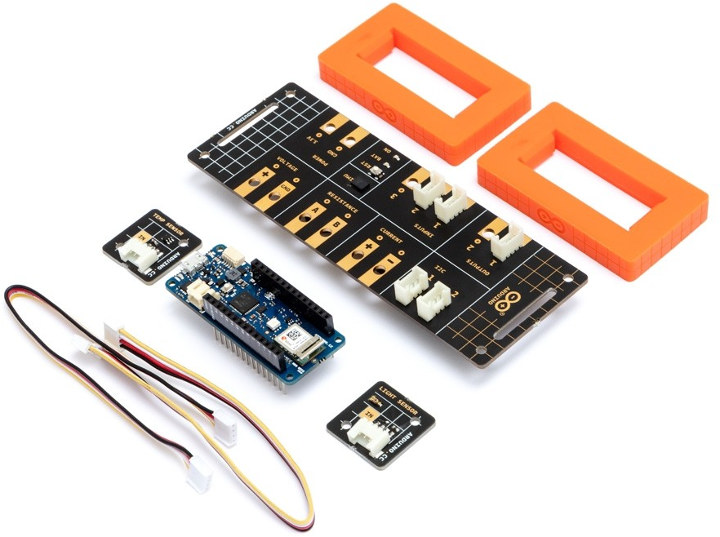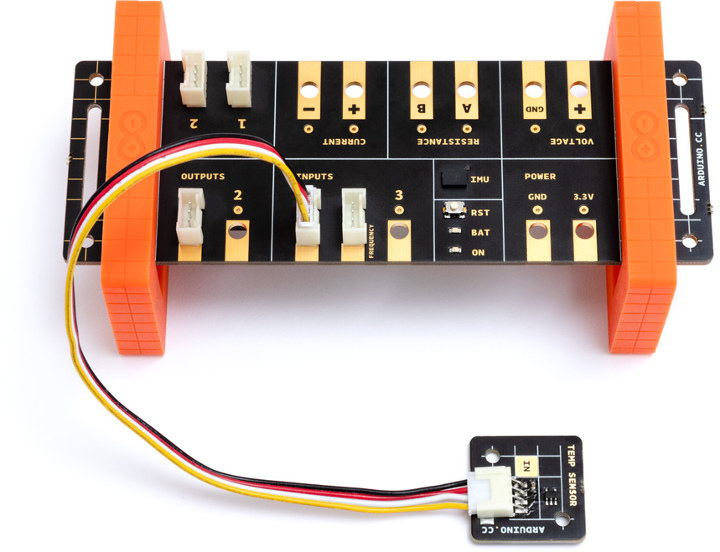Google and Arduino have partnered together to developer and launch the Arduino Science Kit Physics Lab, the first official Arduino kit designed for middle school curriculum (ages 11 to 14).
Based on Arduino WiFi MKR1010, the science kit will allow pupils to experiment with forces, motion, and conductivity, and log data with Google’s Science Journal “digital science notebook” app for Android.
Arduino Science Kit Physics Lab kit content:
- Arduino MKR WiFi 1010 based on Microchip SAMD21 Cortex-M0+ MCU and Espressif Systems ESP32 WiSoC (WiFi + Bluetooth)
- Arduino Science Carrier Board
- 2x Silicone standoffs
- 1x Flat micro USB cable
- 1x Grove-compatible light sensor module
- 1x Grove-compatible temperature sensor module
- 1x Grove-compatible white LED module
- 3x Grove Cable 20cm – universal 4-pin connector
- 2x Double-ended cable: crocodile clip/banana plug (50 cm), 2x Double-ended cable crocodile clip/banana plug (20 cm)
- 1x Magnet
- 1x Hook-and-loop Velcro strap, 1x Hook-and-loop Velcro dot
- 2x PCB sticks, 1x PCB encoder
- 1x Mini slinky metal spring
- 8x Flat head M3 screws, 8x M3 bolts
- 4x Rubber bands, 4x Small silicone gaskets, 2x Big silicone gaskets
Online courses for nine science projects inspired by popular fairground rides like the Gravitron and Pirate Ship will be made available to students and teachers:
- Electromagnetism and Thermodynamics
- ELECTRIC FORTUNE TELLER: Investigate resistivity, and voltage of different materials.
- BUZZ WIRE: Build a conductive ‘maze’ and then try to avoid the buzzer as you guide the loop around your course.
- HAUNTED HOUSE THEREMIN: Make paranormal noise with a magnet.
- THERMO MAGIC SHOW: Learn about how different materials conduct or insulate heat.
- Kinetics and Kinematics
- The DROP ZONE: Explore gravity and measure the acceleration of your Arduino board.
- The GRAVITRON: Learn about rotations per minute, circular motion, the force required to spin this ride, and the relationship to centrifugal forces.
- The PIRATE SHIP: Captain the ship and test the oscillation of a pendulum.
- The EJECTION SEAT: Make your board bounce to learn about harmonic motion.
- The SPHEROTRON: Learn more about potential energy and motion.
Arduino further explains no prior electronics knowledge is required to use the kit, and students would run upload their sketch using Arduino Create for Chromebook, connect their Android mobile device to the board, build their project, and then use the onboard sensor and plug-and-play modules to simulate the rides’ dynamics.
The resulting data is transmitted to the smartphone via ESP32’s Bluetooth radio , and finally results can be analyze in Google’s Science Journal App or worksheets.
The Physics Labs will be launched in March 2019 for a yet-to-be-defined price. More details may be found on the product page.

Jean-Luc started CNX Software in 2010 as a part-time endeavor, before quitting his job as a software engineering manager, and starting to write daily news, and reviews full time later in 2011.
Support CNX Software! Donate via cryptocurrencies, become a Patron on Patreon, or purchase goods on Amazon or Aliexpress. We also use affiliate links in articles to earn commissions if you make a purchase after clicking on those links.






